Palampur, Himachal Pradesh
Palampur is a hill station and a municipal council in the Kangra Valley in the Indian state of Himachal Pradesh. It is surrounded by pine forests and flanked by the Dhauladhar ranges. The town derives its name from the local word palum, meaning "much water". There are numerous streams flowing from the mountains to the plains from Palampur. The combination of greenery and water gives Palampur a distinctive look.
Palampur | |
|---|---|
City | |
| Palampur | |
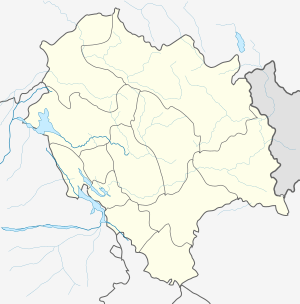 Palampur Location in Himachal Pradesh, India  Palampur Palampur (India) 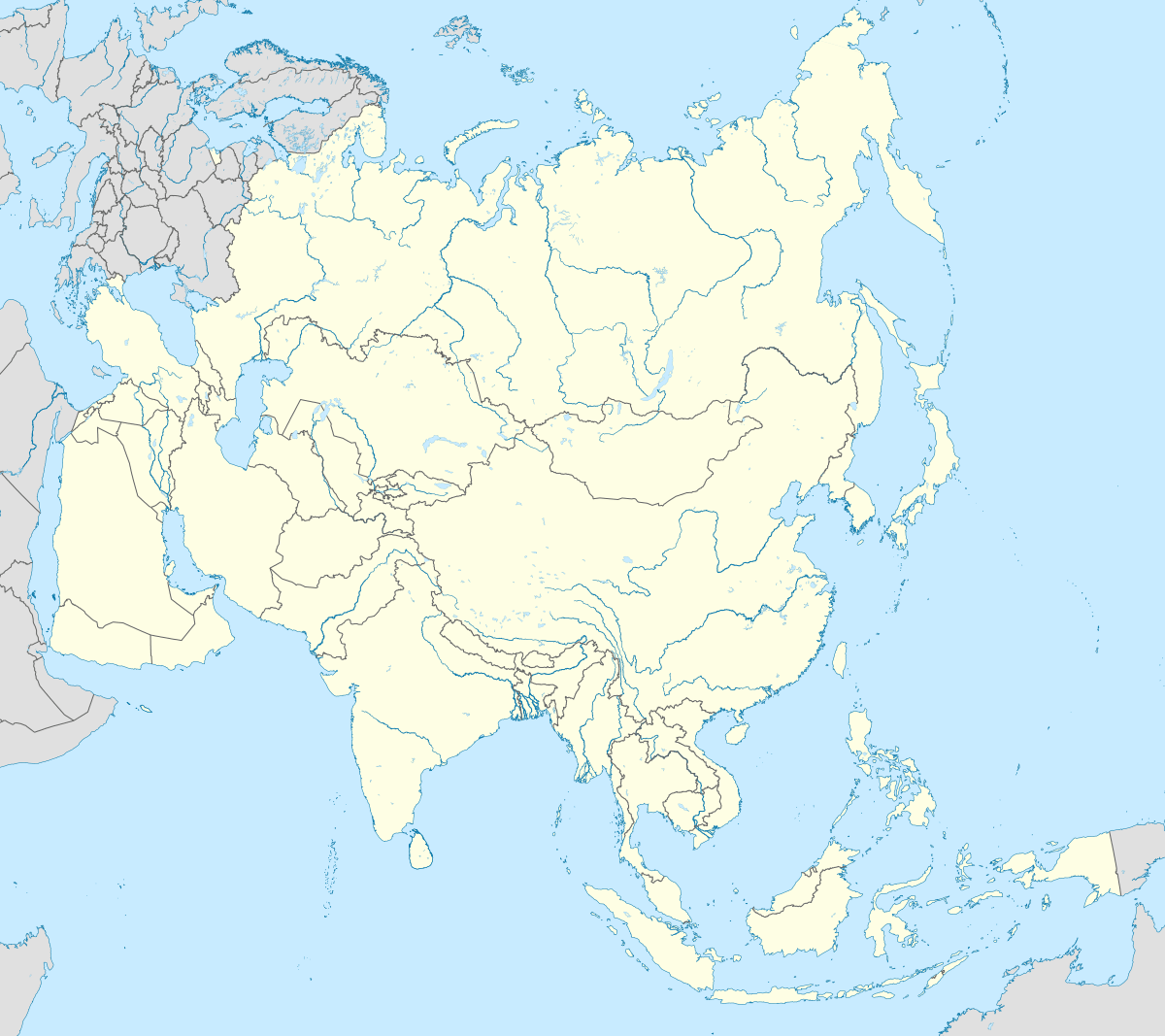 Palampur Palampur (Asia) | |
| Coordinates: 32.109722°N 76.536641°E | |
| Country | |
| State | Himachal Pradesh |
| District | Kangra |
| Named for | "Palm" the local fruit |
| Elevation | 1,472 - 2,350 m (−6,238 ft) |
| Population (2011) | |
| • Total | 3,543[1] |
| Language | |
| • Official | Hindi,[2] |
| • Additional official | Sanskrit[3] |
| Time zone | UTC+5:30 (IST) |
| PIN | 176061 |
| Vehicle registration | HP-37 |
History
Palampur is an important city located in Kangra Valley. It is a famous hill station and was once a part of the Jalandhar kingdom. The town came into being when Dr. Jameson, Superintendent of Botanical Gardens, introduced the tea bush from Almora in 1849. The bush thrived and so did the town which became a focus of the European tea estate owners with an exception of the famous (former) Wah Tea Estate which was owned by Nawab Muhammad Hayat Khan and his descendants, until 1947.[4] Since then, the Kangra tea of Palampur has been known internationally.
The first prime minister of independent India, Pandit Jawahar Lal Nehru visited Palampur in 1941 when it was still British India. There is a Nehru Chowk in Palampur to commemorate this event.
Pre-independence
During the second half of the 19th century, with the success of tea estates in the Palampur area, the original settlement started developing. In 1888, it was made a tehsil headquarter, by shifting the same from Bhawarna. The tea estate owners impressed upon the administration to bring infrastructure like St. Paul's Senior Secondary School, Palampur, colleges and hospital. It also became a center of laborers engaged in the plucking of tea leaves and packing, transportation and marketing thereof.
The earthquake of 1905 left a trail of destruction. Therefore, building style, projections, and building material had to be modified. The tehsil complex, school, and church towards T-Bud Hotel were built during the British Period. Consequent upon laying of the railway line for the hydro-electric project at Joginder Nagar in 1927 and the installation of the railway station and staff quarters, construction activity grew fast. An increase in the employment, led to investment in the area, whereby multifarious development including roads took place.
Post independence
In 1947, Sobha Singh, a well known contemporary painter moved from Punjab to Andretta and developed his art gallery. He painted art pieces related to Punjabi culture and shot into prominence as an artist. After 1946, the regional linkages of town started improving. A military station was established at Holta, a strategic location of the town. CSK Himachal Pradesh Agricultural University was established in which Dhauladhar Hostel was inaugurated on 15 March 1985 which proved to be the stepping stone of the university's success, besides the establishment of Indian Council for Scientific & Industrial Research (CSIR) Complex (Institute of Himalayan Bioresource Technology).[5] Many offices at the level of subdivision pertaining to Electricity, Housing Board, Public health and PWD (B&R) were located. Tourist accommodation like T-Bud Hotel by Himachal Tourism Development Corporation and other leisure hotels were constructed.[6]
Markets
The markets in Palampur are one of the most upscale markets in the Kangra District of Himachal Pradesh. Numerous shopping complexes have mushroomed during the last decade and showrooms of internationally renowned brands have come up. Besides this, old co-operatives like Bhuttico, which are hallmarked for their quality in woolens, have also set up shops.
The market has numerous shops where you can buy grocery, fresh fruit and vegetables, stationery, electrical appliances and almost anything that you may require. There are numerous restaurants serving a wide variety of fare including Chinese, Continental, Indian and so on. There are a few places where you can taste authentic local food too. Also some hotels and dhabas serve the traditional Kangri Dham which is confined to this particular part of the world.
In addition, 3M Plaza Shopping Mall at Maranda (Mall and Pearl Cinema Multiplex) & Grand Plaza at Scandal Point, Palampur are commercial complexes where almost all apparels branded showrooms/multi-branded showrooms are present. Also fast food chains like Dominos, Cafe Coffee Day, and Republic of Chicken operate outlets in the city.
Administration
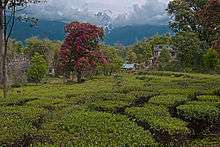
Palampur has seven wards. It is one of the ten major cities of Kangra district.
Demographics
As of 2011 Indian Census, Palampur had a total population of 3,543, of which 1,814 were males and 1,729 were females. It has a sex ratio of 953 females to 1000 males. Population within the age group of 0 to 6 years was 254. The total number of literates in Palampur was 3,004, which constituted 84.8% of the population with male literacy of 85.9% and female literacy of 83.6%. The effective literacy rate of 7+ population of Palampur was 91.3%, of which male literacy rate was 93.0% and female literacy rate was 89.6%. The Scheduled Castes and Scheduled Tribes population was 785 and 17 respectively. Palampur had 842 households in 2011.[1]
Geography
Palampur is at 32.12°N 76.53°E,[7] at a height of 1472 m meters above sea level. It is in the northwestern region of Himachal Pradesh in north India and is only 30 km from the popular hill station of Dharamshala.
Distance from major cities
- Distance from Chandigarh: 250 km
- Distance from Joginder Nagar: 37 km
- Distance from Shimla: 213 km
- Distance from Mandi: 92 km
- Distance from Dharamshala: 36 km
Climate
Palampur has a monsoonal-influenced humid subtropical climate (Cwa) with hot summers and cool winters. Late summer and early spring see massive amount of monsoonal rain.
| Climate data for Palampur | |||||||||||||
|---|---|---|---|---|---|---|---|---|---|---|---|---|---|
| Month | Jan | Feb | Mar | Apr | May | Jun | Jul | Aug | Sep | Oct | Nov | Dec | Year |
| Average high °C (°F) | 14.1 (57.4) |
13.9 (57.0) |
18.1 (64.6) |
24.1 (75.4) |
25.7 (78.3) |
25.9 (78.6) |
25.2 (77.4) |
24.1 (75.4) |
23.3 (73.9) |
23.4 (74.1) |
20.6 (69.1) |
14.8 (58.6) |
21.1 (70.0) |
| Average low °C (°F) | 5.8 (42.4) |
4.1 (39.4) |
8.8 (47.8) |
10.8 (51.4) |
14.5 (58.1) |
16.3 (61.3) |
16.7 (62.1) |
20 (68) |
15.9 (60.6) |
15.3 (59.5) |
10.7 (51.3) |
4.8 (40.6) |
12.0 (53.5) |
| Average precipitation mm (inches) | 119 (4.7) |
94 (3.7) |
112 (4.4) |
54 (2.1) |
56 (2.2) |
136 (5.4) |
710 (28.0) |
738 (29.1) |
324 (12.8) |
72 (2.8) |
23 (0.9) |
55 (2.2) |
2,493 (98.3) |
| Source: [8] | |||||||||||||
Politics
Palampur is a state legislative constituency in Himachal Pradesh. Lala Kanhiya Lal Butail, was the first representative of Palampur. Palampur is the home city of senior BJP leader Shanta Kumar. The town politics is mostly dominated by the Congress and the Bhartiya Janta Party. BJP leaders from Palampur include Ch. Sarvan Kumar, Praveen Sharma and Shiv Kumar. For Congress, the politics has been dominated by the Butail family. Kunj Behari Lal Butail served as an MLA for over a decade and was also the first Pradesh Congress Committee President.Curently MLA is Ashish Butail.[9]
Connectivity
By Air
Spice Jet and Air India are operating daily flights from New Delhi to Kangra Airport) which is just 40 km from Palampur. Air India has started direct flight from Chandigarh International Airport to Kangra Airport from October 2019.[10]
By rail
Palampur is connected by the narrow gauge Kangra Valley Railway, Pathankot to Joginder Nagar. The railway station is named Palampur (Himachal). It is situated at Maranda, 4 km from bus stand.
By road

Palampur is well connected by road to all major cities and towns in and around the state. Pathankot-Mandi National Highway 154 (India) (Old NH 20) is the major highway that passes through Palampur. Himachal Road Transport Corporation (HRTC) is the best way to travel plying air-conditioned, deluxe and semi-deluxe buses from major cities like Delhi and Chandigarh.
Tourist attractions
Saurabh Van Vihar
Built in the memory of Late Capt. Saurabh Kalia, martyred in the Kargil War, a park was constructed in the Neugal Khad area near Bandla village.
Baijnath Shiva Temple
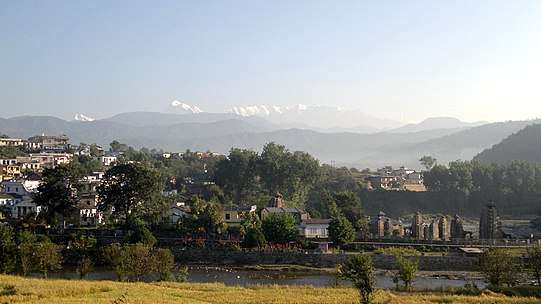
Built during the 12th century, Bajinath[11] is known to be one of the oldest temples of Lord Shiva. The temple bespeaks ancient art and culture through its pristine and spellbinding craftsmanship. The temple premises are extremely spotless and the view from the rear end of the temple is magical. The temple lies between Kangra and Mandi districts of Himachal Pradesh. It is just 16 km from major city Palampur.
Tashi Jong Buddhist Monastery
Tashi Jong can be reached from Palampur or Baijnath. This is a colourful monastery with a meditation hall. One can find some Chinese food stuff there.
Birni Devi Temple
At an altitude of 2240 metres this is one of the easiest treks which you can do with young children and "not so old" parents. The locals have homes on the way and they can guide your way across the forest to reach the Birni top. The car journey ends at Jakhani Mata temple and trek to Birni Mata starts.
Festivals
- Sair is a local festival of Kangra district and is celebrated with great zeal by the people in Palampur. This festival is celebrated on first 'tithi' of 'chaitra mass 'चैत्र मास' every year. Palampur is a place of rivers and rain and in the old days when there were no bridges and less roads people used to die in the river floods. So this festival signifies the offset of rainy season and the black month. On this day people worship the Shair deity. They offer new crop, fruits and vegetables to there deity, they cook many local foods and delicacies and invite their friends and relatives. Newly wed brides return to their in-laws' house after a full month's break at their parents' home. Children celebrate this festival in their own style by playing game with walnuts.
- There is greater sobriety, but no less joy, when Lohri or Maghi comes along in mid January. This is the traditionally mid winter day and also commemorates the last sowing of the Rabi crops. Community bonfires, folk songs and dancing, mark the festival. Local folk songs known as 'lukdiyan' are sung by children, door to door. A special type of sacrament is being made from roasted rice, sugar and peanuts called as 'tilcholi'.
- Palampur Holi Fair is held at Capt. Vikram Batra Stadium. On these days many cultural activities are held. Many singers visit Palampur fair on these days, and tableaux representing different gods are made.
Tourism

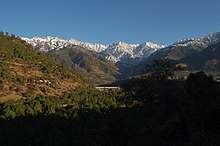
Behind the town stands high ranges of Dhauladhar mountains (white hill of snow), whose tops remain covered for most of the year. This place is being developed as large tourist centre. A ropeway and an amusement park are on the way to be established here. An agricultural university is functioning nearby. An Ayurvedic hospital and one Ayurvedic medical college is in Paprola is about 10 km away. Some tea factories are in operation. Kangra valley is known its tea gardens. On the outskirts of Palampur, Neugal stream is a thin stream running over stony ground far below the cliff. There is a trek to Bundla Falls which cascade from a height of 100 meters. A recreational spot, called Saurabh Van Vihar, in Bundla, gets its name from Capt. Saurabh Kalia who hails from Palampur. Several trek routes lead out of Palampur, particularly over the Dhauladhar Mountains towards the districts of Chamba and Kullu, Himachal Pradesh. Some important treks are over the Sanghar pass to Bharmaur via Holi, the Thamsar Pass (4,747 metres above MSL) from Billing to Manali via Bara Bhangal, over the Jalsu pass from Baijnath to Bharmaur, and the forest trek from Mcleodganj to Triund. A four-day trek will lead the traveler to Holi, via Waru La. Twenty-eight kilometers from Palampur is Billing, near Bir an important centre for paragliding. Paraglider pilots often land near Palampur after cross-country flights starting from Billing. Palampur has numerous Buddhist monasteries.
Palampur is a rapidly developing city of Himachal Pradesh with plenty of accommodations. The upper areas of Palampur experience heavy snowfall and thereby providing plenty of opportunity for tourists to get themselves indulged in winter sports activities or enjoy a stroll through the tea gardens. Palampur has emerged as one of the favourite places for movie shooting lately. Directors like Imtiaz Ali and Lawrence D'Souza have shot movies here. A ropeway has been proposed across the Neugal river which will further attract tourists.
Palampur is at the center of all major tourist attractions, with Dharamshala on one side and Baijnath and Manali on the other. One can easily find good and affordable places to stay in the town. You can find hotels, home stays, villas and cottages at very competitive prices. There are also a good number of restaurants in the main market serving a variety of cuisines.
Some tourist sites around Palampur include:
The Solitude Camp: Free from city noise, technology, and other modern interference, The Solitude Camp is an undisturbed and peaceful place in the foothills of the majestic Dhauladhar Mountains. The Solitude Camp is around 7 km from Palampur towards the old Vindhyavasini temple road. The place is situated near the Neugal stream and has a nearby waterfall and amazing views of the Dhauladhar mountains. The place also offers tourism activities like trekking, River crossing and rock climbing on request.
Chamunda Devi Temple (20 km from Palampur): This is a very important Hindu shrine with the temple of Goddess Chamunda. Thousands of devotees from all over India visit the temple and offer prayers.
Bir and Billing (35 km from Palampur): This village is famous for its Buddhist monasteries. Hang gliding pilots use it as their landing site. Bir, surrounded by tea gardens and an amphitheater of low hills, is an ideal landing around for paragliders. Bir has Buddhist monasteries that are worth visiting. Fine Tibetan handicrafts are also produced here. Billing, up in the hills and 14 km from Bir with an arena of 200 km for high-altitude and cross-country flying, is one of the best aerosports sites in the country.
Baijnath (16 km from Palampur): The Shiva temple at Baijnath is one of the most remarkable monuments of the Kangra valley. Ancient name of this town was 'Kirgrama'. Baijnath got its name from Shiva Vaidyanatha. The temple consists of an 'Adytum' surrounded by a spire of the usual conical shape with a 'Mandap' covered with a low, pyramid-shaped roof. The 'Adytum' contains the Lingam. There is fine sculpture work associated with Ravana, who worshipped Shiva at this spot and gained immortality. Shivratri of Baijnath is a well-attended fair.

Neugal Khad (2 km from Palampur): Neugal Khad provides a fine view of the Dhauladhar range. It is roaring in the rainy season and gurgling all the year round. Himachal Tourism cafe provides food and a view from its restaurant. It is a picnic spot.
Bundla Stream (2 km from Palampur): Bundla stream with wide chasm of more than 100 metres, swells up and rises madly in monsoons taking stones and boulders along with it making a loud noise like that of continuous thunder. The walk from Palampur to Bundla should not be missed as you can visit the tea gardens too.
Bundla Tea Estate (2 km from Palampur): This tea estate in Palampur, which covers Bundla, Aima and Lohna panchayats, falls on the road between Neugal Café and main Palampur town. The lush green tea gardens are at its best in the monsoon. People can be seen plucking tea from April till October. The old Bundla Tea Estate complex, which is over 200 years old can be seen from the road.
Andretta (13 km from Palampur): It is the home of the artist, late Sardar Sobha Singh and late playwright Norah Richards. Sobha Singh's Art Gallery is also situated in Andretta.
Saurabh Van Vihar (4 km from Palampur): Named after the valiant Army officer, Captain Saurabh Kalia, Saurabh Van Vihar is on the banks of Neugal stream. Managed by the Himachal Pradesh Forest Department, the Van Vihar was set up with the purpose of providing information to the tourists about the nature and environment. The Vihar sprawls over an area of 35 acres and there is a green park located here. The area is surrounded by the Dhauladhar mountains and offers a scenic view.
Gopalpur Zoo (14 km from Palampur): This zoological park, officially known as Dhauladhar Nature Park, developed by H.P government, is a good place for animal lovers and children. The park has a wide range of animals such as lion, leopard, bear, porcupine.
Chamunda Devi Temple[12] (21.2 km from Palampur): Chamunda Devi, also known as Chamundi, Chamundeshwari and Charchika, is a fearsome aspect of Devi, the Hindu Divine Mother and one of the seven Matrikas (mother goddesses). She is also one of the primary Yoginis, a group of sixty-four or eighty-one Tantric goddesses, who are family and friends of the warrior goddess Durga. The name is a collaboration of Chanda and Munda, two monsters whom Chamunda killed. She is carefully related with Kali, another fierce aspect of Devi. She is sometimes recognized with goddesses Parvati, Chandi or Durga as properly. The goddess is often represented as haunting cremation reasons or fig trees. The goddess is worshipped by ritual animal sacrifices along with offerings of wine and in the ancient times, human forfeit were offered too. Initially a tribal goddess, Chamunda was assimilated in Hinduism and later entered the Jain pantheon, too. Though in Jainism, the rites of her worship include all-vegetable offerings, and not the meat and liquor offerings.
Jakhni Mata Mandir: The Mata Jakhni Mandir is a Hindu Temple in the city of Palampur, Himachal Pradesh, India. Dedicated to Mata Jakhni, it is located near Birni Devi Temple at Chandpur Village near Palampur City, Palampur. As per local folklore, it is said to have been in existence since ancient period around 450 years old when Mata Jakhni Image was brought by a family of Gaddi Group from Bharmour, where her image is worshiped. This place is also explored by trekkers and tourists.
Education and research
Notable persons
- Captain Vikram Batra (PVC)
- Captain Saurabh Kalia
- Major Som Nath Sharma (PVC)
- Major Sudhir Kumar Walia (AC)
References
- "Census of India: Palampur". www.censusindia.gov.in. Retrieved 5 January 2020.
- "Report of the Commissioner for linguistic minorities: 52nd report (July 2014 to June 2015)" (PDF). Commissioner for Linguistic Minorities, Ministry of Minority Affairs, Government of India. pp. 33–34. Archived from the original (PDF) on 28 December 2017. Retrieved 16 February 2016.
- Pratibha Chauhan (17 February 2019). "Bill to make Sanskrit second official language of HP passed". The Tribune. Shimla. Archived from the original on 18 February 2019. Retrieved 18 February 2019.
- Shaukat Hayat Khan: Memoirs, Lahore:Jang Publications, 1993
- "IHBT Website". IHBT. Retrieved 17 January 2012.
- "Blog of Himachal". Retrieved 15 August 2011.
- "Maps, Weather, and Airports for Palampur, India".
- "CLIMATE: PALAMPUR". Climate-Data. Retrieved 31 March 2017.
- "Himachal polls: Brij Bihari Lal Butail is the richest candidate with Rs 150 crore assets – Times of India".
- "सत्रह सौ रुपये में चंडीगढ़ से गगल पहुंचाएगी एयर इंडिया". Amar Ujala. 29 October 2019. Retrieved 27 March 2020.
- Shiva Temple Palampur.
- Chamunda Devi Temple.
